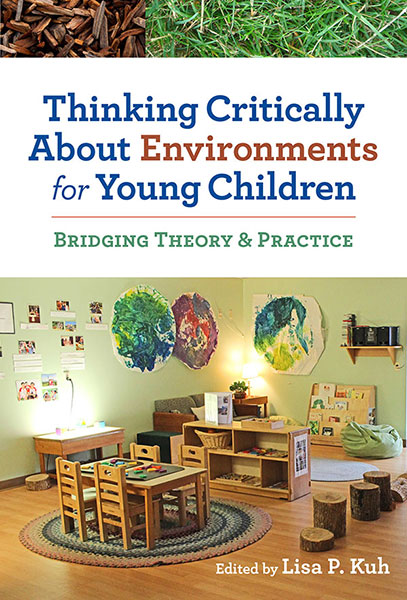Professors: Request an Exam Copy
Print copies available for US orders only. For orders outside the US, see our international distributors.
Edited by: Lisa P. Kuh
Publication Date: June 20, 2014
Pages: 216
Series: Early Childhood Education Series

This comprehensive book will help early childhood practitioners consider the “why” and “how” of setting up classrooms and other learning spaces to create environments that are most conducive to child development. Using a practice-based focus and a researcher lens, the contributors consider the ways in which environments for children enhance or diminish educational experiences, how social constructs about what is good for children influence environmental design, and what practitioners can do in their own work when creating learning environments for young children. There are copious examples from practice, lessons learned, and illustrations and photographs of key aspects of the environments they discuss. Organized into three parts, this essential text addresses:
A unique combination of the philosophical and practical aspects of formal and informal environments, this volume enables educators to create and articulate why carefully designed children’s spaces are critical to their learning and development.
Lisa P. Kuh is an assistant professor in the Family Studies Department at the University of New Hampshire, the consultant for Pedagogy and Inquiry at the UNH Child Study and Development Center, and coordinator of the undergraduate early childhood teacher preparation program. She is coprincipal investigator on the Natural Playground Project.
“Challenges us to create spaces that inspire young children’s exploration, play, and deep learning, and provides theoretical and practical tools to support our efforts.”
—Benjamin Mardell, Lesley University
“These pages bring a new appreciation for the ways in which the environment shapes what and how children learn. It’s an enlightening book that gives educators new lenses for thinking about and creating the kinds of places that can optimize children's growth and learning, especially in this era of standardization. Educators need this book!”
—Nancy Carlsson-Paige, professor emerita, Lesley University
“This book invites educators to ‘read’ environments for young children critically: Does the physical design of classrooms, school grounds, and informal settings like museums really encourage creative, independent learning? For everyone who wants to take educational settings beyond minimal standards, this collection is a thoughtful and inspiring guide.”
—Louise Chawla, professor, Environmental Design Program, University of Colorado, Boulder
“The authors vividly portray environments as dynamic, shifting entities imbued with the meaning of what is envisioned, expected, and encouraged by their creators – or not. As such, a call to “set an intent” has been heralded to create environments informed by particular children, parents, and teachers who learn in particular places, at particular times.”
—Mary Jane Moran, associate professor, Child and Family Studies, The University of Tennessee, Knoxville
Professors: Request an Exam Copy
Print copies available for US orders only. For orders outside the US, see our international distributors.